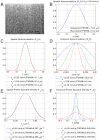Quantitative cerebral blood flow with optical coherence tomography
- PMID: 20174075
- PMCID: PMC2837842
- DOI: 10.1364/OE.18.002477
Quantitative cerebral blood flow with optical coherence tomography
Abstract
Absolute measurements of cerebral blood flow (CBF) are an important endpoint in studies of cerebral pathophysiology. Currently no accepted method exists for in vivo longitudinal monitoring of CBF with high resolution in rats and mice. Using three-dimensional Doppler Optical Coherence Tomography and cranial window preparations, we present methods and algorithms for regional CBF measurements in the rat cortex. Towards this end, we develop and validate a quantitative statistical model to describe the effect of static tissue on velocity sensitivity. This model is used to design scanning protocols and algorithms for sensitive 3D flow measurements and angiography of the cortex. We also introduce a method of absolute flow calculation that does not require explicit knowledge of vessel angles. We show that OCT estimates of absolute CBF values in rats agree with prior measures by autoradiography, suggesting that Doppler OCT can perform absolute flow measurements in animal models.
Figures







Similar articles
-
Aging-associated changes in cerebral vasculature and blood flow as determined by quantitative optical coherence tomography angiography.Neurobiol Aging. 2018 Oct;70:148-159. doi: 10.1016/j.neurobiolaging.2018.06.017. Epub 2018 Jun 22. Neurobiol Aging. 2018. PMID: 30007164 Free PMC article.
-
In vivo imaging of the rat cerebral microvessels with optical coherence tomography.Clin Hemorheol Microcirc. 2004;31(1):31-40. Clin Hemorheol Microcirc. 2004. PMID: 15272151
-
Monitoring of drug and stimulation induced cerebral blood flow velocity changes in rat sensory cortex using spectral domain Doppler optical coherence tomography.J Biomed Opt. 2011 Apr;16(4):046001. doi: 10.1117/1.3560286. J Biomed Opt. 2011. PMID: 21529070
-
Doppler optical coherence tomography.Prog Retin Eye Res. 2014 Jul;41(100):26-43. doi: 10.1016/j.preteyeres.2014.03.004. Epub 2014 Apr 3. Prog Retin Eye Res. 2014. PMID: 24704352 Free PMC article. Review.
-
Optical detection of brain function: simultaneous imaging of cerebral vascular response, tissue metabolism, and cellular activity in vivo.Rev Neurosci. 2011;22(6):695-709. doi: 10.1515/RNS.2011.053. Epub 2011 Nov 18. Rev Neurosci. 2011. PMID: 22098474 Review.
Cited by
-
Adaptive anisotropic diffusion for noise reduction of phase images in Fourier domain Doppler optical coherence tomography.Biomed Opt Express. 2016 Jul 5;7(8):2912-26. doi: 10.1364/BOE.7.002912. eCollection 2016 Aug 1. Biomed Opt Express. 2016. PMID: 27570687 Free PMC article.
-
Speckle variance optical coherence tomography of the rodent spinal cord: in vivo feasibility.Biomed Opt Express. 2012 May 1;3(5):911-9. doi: 10.1364/BOE.3.000911. Epub 2012 Apr 10. Biomed Opt Express. 2012. PMID: 22567584 Free PMC article.
-
In Vivo Calcium Imaging of Cardiomyocytes in the Beating Mouse Heart With Multiphoton Microscopy.Front Physiol. 2018 Jul 31;9:969. doi: 10.3389/fphys.2018.00969. eCollection 2018. Front Physiol. 2018. PMID: 30108510 Free PMC article.
-
Single capillary oximetry and tissue ultrastructural sensing by dual-band dual-scan inverse spectroscopic optical coherence tomography.Light Sci Appl. 2018 Aug 29;7:57. doi: 10.1038/s41377-018-0057-2. eCollection 2018. Light Sci Appl. 2018. PMID: 30839641 Free PMC article.
-
Multiple-object geometric deformable model for segmentation of macular OCT.Biomed Opt Express. 2014 Mar 4;5(4):1062-74. doi: 10.1364/BOE.5.001062. eCollection 2014 Apr 1. Biomed Opt Express. 2014. PMID: 24761289 Free PMC article.
References
-
- Sakurada O., Kennedy C., Jehle J., Brown J. D., Carbin G. L., Sokoloff L., “Measurement of local cerebral blood flow with iodo [14C] antipyrine,” Am. J. Physiol. 234(1), H59–H66 (1978). - PubMed
Publication types
MeSH terms
Grants and funding
- K99 NS067050/NS/NINDS NIH HHS/United States
- R01-CA075289-13/CA/NCI NIH HHS/United States
- R01 CA075289/CA/NCI NIH HHS/United States
- P50NS010828/NS/NINDS NIH HHS/United States
- P50 NS010828/NS/NINDS NIH HHS/United States
- R01 EY011289/EY/NEI NIH HHS/United States
- P01 NS055104/NS/NINDS NIH HHS/United States
- R00 NS067050/NS/NINDS NIH HHS/United States
- R01-NS057476/NS/NINDS NIH HHS/United States
- P01NS055104/NS/NINDS NIH HHS/United States
- R01 NS057476/NS/NINDS NIH HHS/United States
- K99NS067050/NS/NINDS NIH HHS/United States
LinkOut - more resources
Full Text Sources
Other Literature Sources

